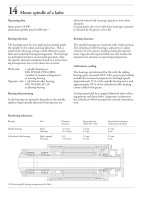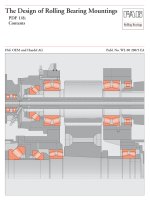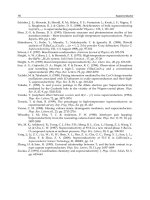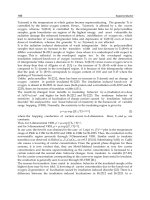The Design of Rolling Bearing Mountings Part 6 pot
Bạn đang xem bản rút gọn của tài liệu. Xem và tải ngay bản đầy đủ của tài liệu tại đây (627.25 KB, 15 trang )
42: Axle box roller bearings of an Intercity train carriage
43– 44 UIC axle box roller bearings for freight cars
The car body is supported by laminated springs on the
wheelset.The laminated springs have the additional
job of guiding the wheelset. To limit the swaying mo-
tion of the car body and to accommodate the thrust
peaks, the housing features guiding surfaces in which
the axle support of the frame is engaged. Cylindrical or
spherical roller bearings are used as axle box roller
bearings. The housing boundary dimensions of the
UIC bearing are standardized. According to the latest
UIC conditions 130 mm diameter journals are speci-
fied for cylindrical and spherical roller bearings. In
some cases 120 mm journals are used for cylindrical
roller bearings.
Clearance
The tight fit expands the inner ring thus reducing
radial clearance. A further clearance reduction results
from the air stream developed during travel which
cools the outer ring more than the inner ring. There-
fore, cylindrical roller bearings with a radial clearance
of 130 to 180 microns and spherical roller bearings
with increased radial clearance C3 are chosen.
Lubrication, sealing
The axle box roller bearings are lubricated with a lithi-
um soap base grease. Felt seals combined with a laby-
rinth have proved most effective for cylindrical roller
bearings.
UIC axle boxes with spherical roller bearings invari-
ably use only labyrinth seals.
Dimensioning, bearing selection
Operating data 43: UIC axle boxes with 44: UIC axle boxes with
cylindrical roller bearings spherical roller bearings
Deadweight with max. payload G
max
40,000 kg 40,000 kg
Top speed v
max
100 km/h 100 km/h
Wheel diameter D
R
1 m 1 m
Number of wheelsets 2 2
Wheelset weight G
R
1,300 kg 1,300 kg
Weight on axle A 20,000 kg 20,000 kg
Number of bearings per wheelset i
R
4 cylindrical roller bearings 4 spherical roller bearings
Supplementary factor f
z
· f
a
1.3 · 1 = 1.3 1.3 · 1.25 = 1.625
(f
a
= 1 for cylindrical roller bearings where thrust loads
are taken up by the lips;
f
a
= 1.25 for spherical roller bearings where thrust loads
are taken up by the raceways.)
Equivalent load:
P = (A – G
R
) · g · f
z
· f
a
/i
R
(g = 9.81 m/s
2
) 59.6 kN 74.5 kN
Average travelling speed (v
Fm
= 0.75 · v
max
) 75 km/h 75 km/h
Average wheelset speed n = 5,310 · v
Fm
(km/h)/D
R
(mm) 400 min
–1
400 min
–1
Speed factor f
n
0.475 0.475
Index of dynamic stressing f
L
3.5 3.5
Required dynamic load rating of one bearing:
C = f
L
/f
n
· P 439 kN 549 kN
Bearings mounted: Cylindrical roller bearings 2 spherical roller bearings
FAG WJ130x240TVP and FAG 502472AA
FAG WJP130x240P.TVP
Bore x outside diameter x width 130 x 240 x 80 mm 130 x 220 x 73 mm
Dynamic load rating 540 kN 585 kN
Machining tolerances of journals p6 p6
Machining tolerances of housing bores H7 H7
Radial clearance 130 180 µm Clearance group C3
43: UIC axle boxes with cylindrical roller bearings
44: UIC axle boxes with spherical roller bearings
Axle box roller bearings
45 of series 120's three-phase current locomotive
The frame is supported by coil springs and spring seats
which are integrated in the bearing housing. The
spring seats are arranged at different heights. The bear-
ing is guided by an arm on each side which is linked
diagonally to the housing. The arms are supported by
elastic damping springs.
Technical data
Vehicle weight: 84,000 kg
Number of wheelsets: 4
Wheelset weight: 2,250 kg
Axle load: 22,000 kg
Supplementary factor f
z
= 1.5
The locomotive reaches top travelling speeds up to
200 km/h.
Bearing selection
Please refer to example number 42 to determine the
equivalent dynamic load P.
Cylindrical roller bearings of the type NJ and NJP
with the dimensions 180 x 320 x 75 mm are mounted.
Dynamic load rating of one bearing: C = 735 kN. The
outer and inner rings of both bearings are separated by
spacer rings. The inner spacer ring is 2 mm wider than
that of the outer rings.
The axial clearance which arises thereby, is necessary to
compensate for bogie production tolerances. The bear-
ing can always be mounted without preload.
Machining tolerances
The bearing inner rings have circumferential load and
are therefore given a tight fit: Journals to p6. The hous-
ing material, an aluminium cast alloy, has a greater co-
efficient of expansion than cast steel which is why the
tolerance field J7 was selected and not the housing tol-
erance H7 usually taken for cast steel housings.
Bearing clearance
Due to the tight fit the bearing inner rings expand; the
radial clearance becomes smaller. The outer ring is
cooled more than the inner ring by the wind resistance
during travel which leads to a further reduction of
clearance. For this reason bearings with increased
radial clearance C4 have been selected.
Lubrication, sealing
A lithium soap base grease is used for lubrication. On
the wheel side the bearing is sealed by a two-web laby-
rinth seal. A V ring seal protects from contaminants on
the opposite side.
45: Axle box roller bearings of series 120's three-phase current locomotive
46 Axle box roller bearings for the ICE driving unit
The bogie frame is supported by 2 coil springs each on
the bearing housings. The wheelset with the housings
is connected to the bogie by an arm. A setting mecha-
nism enables the mounting of the wheelsets in the
bogies without preload. The bearing units are axially
located by a cover.
Operating data
Axle load: 19,900 kg
Weight of unsprung weight: 2,090 kg
Diameter of wheel 1,040 mm
Maximum speed 250 to 280 km/h.
Bearing selection
FAG tapered roller bearing units TAROL 150/250 are
mounted in the wheelset housings of the series vehicles
with the designation ET 401. The main component of
these units is a double row tapered roller bearing with
the dimensions: 150 x 250 x 160 mm.
Machining tolerances
The cones carry circumferential load and therefore have
a tight fit: journal to p6.
Housing to: H7 (for GGG material)
J7 (for aluminium alloys).
Bearing clearance
A slight axial clearance is required for ideal running be-
haviour of the bogies at top speeds. It is between 0.2
and 0.5 mm after mounting.
Lubrication, sealing
The TAROL 150 is supplied as a complete unit which
is sealed. The sealing system consists of two parallel
outer diameter seated lamellar rings and one single-
web labyrinth acting as a pre-seal. The labyrinth is
shaped as a seal cap and pressed into the cup.
The seal caps are each provided with four discharge
holes through which excess grease escapes. This is par-
ticularly important directly after relubrication. O rings
protect the bearing unit from the penetration of water
in the seating area of the cup.
46: Axle box roller bearings of the ICE driving unit
Axle box roller bearings
47 of the Channel tunnel's freight engine, class 92
Class 92 is used for freight traffic in the Euro tunnel
between Great Britain and the Continent. It is a two-
system engine which means it can be operated on di-
rect current (750 V) as well as on alternating current
(25 kV). The engine with six axles (CoCo) draws loads
weighing up to 1,600 t.
The vertical loads of the bogie are accommodated by
two lateral coil springs on the housing of the axle box
bearings. All lateral and longitudinal forces act via the
guiding journals and sleeves which are attached to the
bogie frame and the housing.
The middle axle of each triple axle bogie is designed as
a floating axle box to insure trouble-free operation in
narrow curves. The two outer axles are designed as
standard axles as customary.
Operating data
Vehicle weight 126,000 kg; two bogies each with three
axles; wheel diameter 1,120 mm; top speed v
max
=
140 km/h;
Power P = 5,000 kW at 25 kV AC
4,000 kW at 750 V DC
Bearing selection
Tapered roller bearing units TAROL 150/250 with
pressed cages (JP) are mounted to the outer standard
axles of the vehicles. The bearings are clearance-adjust-
ed, greased and sealed by the manufacturer. Fey lamel-
lar rings provide for sealing on the side facing the
wheel. A gap-type seal prevents rough dirt from pene-
trating the bearings.
The floating axle is accommodated in two cylindrical
roller bearings whose dimensions are 150 x 250 x
80 mm. The extended inner ring allows axial displace-
ment within the bearing of ± 20 mm at a maximum.
Sealing is achieved at the wheel end by means of long-
webbed labyrinths.
Machining tolerances
The inner rings carry circumferential load and have a
tight fit to p6 on the journal.
The housing bores (point load ) are machined accord-
ing to H7.
Bearing clearance
Prior to mounting, the TAROL units of the standard
axle have an axial clearance of 0.665 0.740 mm and
the cylindrical roller bearing units a radial clearance to
C4 in order to compensate for heat expansion.
Lubrication
Both bearing types are lubricated with a lithium soap
base grease. While the lubricant in the TAROL bear-
ings is only changed during the main inspections, the
floating axle bearings must be relubricated in between.
Due to the constant right to left displacement of the
axle lubricant is removed from the bearing area and
therefore has to be replaced regularly.
47: Axle box roller bearings of the Channel tunnel's freight engine, class 92
48 Axle box roller bearings for an underground train
A car has two bogies. Each axle box roller bearings is
cushioned and guided by rubber-metal silent blocks.
These are arranged between the axle box roller bearing
and the frame opening. They are inclined to the verti-
cal and have an angular cross-section.
Operating data
Weight and maximum payload of one car: 34,000 kg.
Number of wheelsets per bogie: 2.
Wheelset weight G
R
: 1,400 kg.
Supplementary factor f
z
: 1.3.
Equivalent dynamic load P = 22.6 kN.
Wheel diameter D
R
= 900 mm.
Top speed v
max
= 80 km/h.
Bearing selection
Two cylindrical roller bearings are mounted per axle
box: One FAG NJ2318E.TVP2.C3.F2.H25 and one
FAG NJP2318ED.TVP2.C3.F2 (dynamic load rating
C = 430 kN).
Machining tolerances
The bearing inner rings carry circumferential load and
are therefore given a tight fit: journal to m6, housing
to H7.
Bearing clearance
The inner rings increase due to the tight fit: the radial
clearance decreases. The outer rings are cooled more
than the inner rings due to the air stream during travel.
This leads to a further reduction in clearance and
therefore a radial clearance C3 was selected.
Lubrication, sealing
A lithium soap base grease is used for lubrication. A
combination of a felt ring and a labrinth was selected
as a means of sealing.
The labyrinth is provided with two axial webs since the
axle boxes are subjected to extreme dirt.
48: Axle box roller bearings for an underground train
49 Axle box roller bearings for a city train
The bogie frame is supported by Chevron springs on
the axle boxes.
Operating data
The equivalent dynamic load P
m
= 37 kN (calculated
from the various load conditions).
Mean wheel diameter 640 mm.
Maximum speed v
max
= 80 km/h.
Bearing selection
The main component of the FAG bearing units
TAROL 90 used here is a double row tapered roller
bearing whose main dimensions are (d x D x B overall
widths cones/cup) 90 x 154 x 106/115 mm.
Bearing clearance
Prior to mounting, the axial clearance of the bearing
unit TAROL 90 is 530 – 630 microns.
Machining tolerances
The bearing cones carry circumferential load and are
therefore given a tight fit: journal n6.
Lubrication, sealing
Lubrication is with a lithium soap base grease. The
TAROL 90 is sealed at both ends with lamellar rings.
The backing ring also has a collar which forms a gap-
type seal with the lid on the wheel side.
49: Axle box roller bearings for a city train
Axle box roller bearings
50 according to AAR standard*) and modified types
The FAG TAROL unit according to AAR standards is
a compact bearing unit with a double row tapered roll-
er bearing as the main component. Seals at both sides
of the bearing, accessories and the grease filling make
the FAG TAROL a ready-to-mount unit. Neither is
the adjustment of the bearing clearance required. The
so-called NFL design (no field lubrication) is consid-
ered standard today. These TAROL units are no longer
relubricated during operation. The bearing grease is
only renewed during a main inspection.
TAROL units do not have to be mounted into a hous-
ing. An adapter is attached between the TAROL unit
and the bogie frame to transmit the loads and support
the bearing cup on the loaded part of the circumfer-
ence.
FAG supply NARROW and WIDE adapters accord-
ing to the AAR standards as well as special adapters de-
signed for the particular cases of application.
AAR has stipulated the admissible loads for the various
sizes of TAROL units.
Components of the FAG tapered roller bearing unit
TAROL
1 Locking plate
2 Cap screw
3 End cap
4 Bearing cup
5 Bearing cone with roller set
6 Spacer
7 Seal wear ring
8 Seal
9 Backing ring
FAG use two types of seals: the rubbing radial shaft seal
(fig. a) corresponds to the design used by AAR. The
non-rubbing lamellar seal ring (fig. b) was developed
by FAG and tested and approved by AAR.
2
1
3
78 5 6
798
4
50: TAROL units
with a double-row tapered roller bearing
*) Association of American Railroads
a: Rubbing radial shaft seal
b: Non-rubbing lamellar seal
FAG also supply TAROL units in metric dimensions.
They (fig. c) have narrower tapered roller bearings and
smaller sealing and retaining components than the
AAR design. The relevant journals are also shorter re-
sulting in lower bending stresses with the same shaft
diameter than in the case of the AAR arrangement.
Higher wheel loads are therefore admissible.
c: TAROL units in metric dimensions and with short journal
(SK design)
51 Kiln trucks for sand lime brick works
Operating conditions
In sand lime brick autoclaves the wheelset bearings of
the kiln trucks are exposed for many hours to hot
steam of approximately 200 °C at 16 to 22 bars. Due
to corrosion hazard the bearing location should be
protected against penetration of the steam which is
strongly alkaline.
Bearings
Sealing requires major attention when designing the
bearing arrangement. The best solution is the use of
pulverized synthetic FAG sealing agent and solid lubri-
cant Arcanol DF. This lubricant is suitable for tempera-
tures ranging between –200 °C and +300 °C and re-
sists almost any chemical even at high temperatures. It
is non-ageing and water repellent. The powder is
packed into the bearing location penetrating into all
cavities of the arrangement and forming a lubricating
film between balls and raceways, balls and cage and
also between outer ring and housing bore. The film in
the housing bore ensures easy bearing displaceability,
even after prolonged operation. This protects the bear-
ing against detrimental axial preload.
In addition to lubrication Arcanol DF also acts as a
sealing agent. It settles in the sealing gaps of the axle
passage and protects the inside of the bearings against
the ingress of alkaline condensate.
The bearings are designed for a truck with two wheel-
sets accommodating a total weight F
r
of 43 kN.
The bearing load for each bearing is relatively low at
F
r
/4 allowing the use of inexpensive FAG
6208.R200.250.S1 deep groove ball bearings.
Considering the high operating temperatures the
bearings have a particularly large radial clearance
(200 250 or 250 350 microns), are heat-treated
according to S1 (200 °C) and are dimensionally stable.
The bearings of the kiln trucks are mounted on the
shaft as far as its shoulder by means of a punching cap
and fastened securely with a shaft end washer and
screw. They have a loose fit in the housing bore of the
FAG series housing SUB6208. Two bolts attach the
housings to the frame of the trucks. Strips inserted
between housing and frame compensate for any differ-
ences in height due to warping of the truck frame.
Machining tolerances
Shaft: bearing seat j6.
Housing: the diameter of bearing seat is between
0.5 mm and 0.8 mm larger than the bearing O.D.
Sealing
Heat-resistant aramide stuffing box packings seal the
bearing area at the axle passage. The cover flange is also
provided with a heat-resistant seal.
51: Kiln trucks for sand lime brick works
Universal quill drive
52 for threephase current locomotives of series 120
All four wheelsets of series 120's threephase current lo-
comotives are driven. The traction motor arranged
transversely to the direction of travel is connected to
the bogie at three points. The torque of the traction
motor acts via pinion and bullgear on a universal quill
drive which is linked to the bullgear and driving wheel
by the articulated lever coupling. The driving wheel
transmits the tractive force to the rails.
Operating data
Top speed: 200 km/h; number of motors: 4; nominal
power per motor: 1,400 kW; motor speed: max.
4,300 min
–1
.
Bearing selection
The bullgear is supported on the universal quill drive
in two tapered roller bearings FAG 534052 (dimen-
sions: 381.03 x 479.475 x 49.213 mm) which are
mounted in O arrangement. Even with a small bearing
distance there is a relatively large spread and as a result
tilting rigidity is high.
The quill drive housing is stationary. The cones, which
carry point load, have a loose fit. The cups carry cir-
cumferential load and have therefore a tight fit in the
rotating bullgear.
The axial clearance of the bearing pair depends on the
machining tolerances of the bearing seats and the oper-
ating conditions. With inner and outer spacer sleeves
bearing adjustment is not necessary when mounting.
Lubrication
During mounting the bearings and the space between
the webs of the outer spacer sleeves are completely
filled with a lithium soap base grease of the NLGI class
2. They are relubricated after every 150,000 km. The
grease is fed through the holes of the sleeve's web.
52: Bullgear bearing arrangement for a universal quill drive
Suspension bearing arrangement
53 for electric goods train locomotive
The torque of the traction motor is transmitted to the
wheelset axle via pinion and bullgear. The traction mo-
tor arranged transversely to the direction of travel is
supported directly on the wheelset axle in two bearing
locations. The reaction torque is taken up by another
support point at the bogie frame.
Operating data
Six driven wheelsets, power per traction motor:
500 kW. Max. speed: 100 km/h.
Bearing selection, dimensioning
For a suspension bearing to have a long service life
(nominal life over 2 million kilometres) roller bearings
with a high load carrying capacity are selected. A me-
dium drive torque and a medium speed are taken as a
basis for dimensioning. The index of dynamic stressing
f
L
should be 3.5 at least. Usually it is well above it.
Two FAG tapered roller bearings are mounted their di-
mensions being 230.188 x 317.5 x 47.625 mm and
231.775 x 336.55 x 65.088 mm. They are abundantly
dimensioned because of the large shaft diameter. High
loads due to vibrations and shocks are accommodated
by special tapered roller bearings with reinforced
pressed cage (reduced number of rollers).
Both tapered roller bearings are mounted in O arrange-
ment with little axial clearance (0.2 0.3 mm). When
the shaft has a maximum load the cups and cones are
tilted by up to 3' against each other. The profile of the
tapered rollers or raceways are modified (slightly
crowned) in order to avoid edge stressing.
Machining tolerances
The cups have circumferential load and an interference
fit on the shaft. The cup or the angle sleeve in the
housing is given a tight fit (perhaps a drive seat).
Lubrication, sealing
The suspension bearings are lubricated with a lithium
soap base grease of penetration class 3 with anti-corro-
sion additives. Baffle plates hold the grease at the bear-
ing (grease storage).
The relubrication interval is about 200,000 to
300,000 km depending on the type of operation.
Labyrinth gap-type seals protect the bearing from con-
taminants.
53: Suspension bearing arrangement for electric goods train locomotive
54 Spur gear transmission for the underground or subway
The drive of modern suburban vehicles should provide
for a high degree of travel comfort, low noise, and be
economical at the same time. These requirements are
fulfilled by a new compact drive package which is
completely supported on springs in the bogie.
Operating data
Two step parallel shaft drive, helical/double helical
gearing. Drive speed (input shaft) n
max
= 5,860 min
–1
,
step-up i = 11.025.
The drive motor is flanged on to the transmission. A
universal joint coupling transmits the torque directly
to the wheelset from the transmission. The gearbox
case, which is split at axis height, is made of high-
strength cast aluminium. This is 25 % lighter than
spheroidal graphite cast iron.
Bearing selection
Input shaft
The rotor of the drive motor is firmly attached to the
input shaft of the transmission. An elastic coupling
which can be subject to bending, avoids constraining
forces in the shaft line which is supported in three
positions by a locating-floating bearing arrangement.
The floating bearing in the motor is a cylindrical roller
bearing FAG NU212E (not illustrated). A second
floating bearing, a cylindrical roller bearing FAG
NJ215E, is at the motor end of the input shaft. The
locating bearing arrangement of the input shaft is an
angular contact ball bearing pair FAG 7215B.UA70 in
X arrangement. Both angular contact ball bearings are
fitted in an angle sleeve made of steel. Therefore differ-
ent heat expansion coefficients of steel and light metal
cannot have a direct effect on the bearings.
The bearings accommodate high speeds with a close
axial guidance at the same time. This means tight fits
for the bearing rings on the shaft and in the bore of the
angle sleeve. The demand for a sufficient axial operat-
ing clearance in addition to the tight fit is met with an-
gular contact ball bearings in universal design. The axial
clearance of the bearing pair prior to mounting is
70 microns.
Intermediate shaft
A spherical roller bearing FAG 22218E is mounted as
the locating bearing of the intermediate shaft. Its outer
ring is in a steel angle sleeve. The spherical roller bear-
ing accommodates chiefly axial forces from the gear-
ing. The floating bearing, a cylindrical roller bearing
FAG NJ2216E.C3, is directly in the light-metal hous-
ing with the outer ring. The very tight fit in the hous-
ing necessitates a bearing with increased radial clear-
ance (C3).
Output shaft
The output shaft whose large spur gear has a double
helical gearing, is axially guided by the spherical roller
bearing of the intermediate shaft. The floating bearing
arrangement with two cylindrical roller bearings FAG
NUZ1848 is therefore sufficient for the output shaft.
The NUZ design with an extended inner ring raceway
allows a large axial displacement of the hollow shaft.
Machining tolerances
Angular contact ball
bearing pair Shaft k5; pair housing K6
Spherical roller bearing Shaft m5; housing K6
Cylindrical roller bearing/
intermediate shaft Shaft m5; housing N6
Cylindrical roller bearing/
output shaft Shaft n5; housing
N6 P6
Lubrication
All the bearings of the transmission are lubricated by
the oil circuit of the gearings.
Antriebs-Hohlwelle
Zwischenwelle
Eingangswelle
54: Spur gear transmission for the underground or subway
Output hollow shaft
Intermediate shaft
Input shaft









